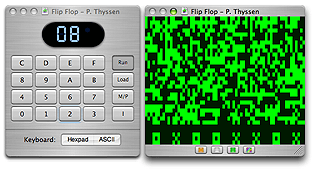
The object of this small strategy game is to change a row of 8 "X"s to 8 "O"s; the catch is that a changing a character at one position also changes another. The number of moves you've made is displayed in hexadecimal on the hex display.

|
To play Flip Flop, first load it and click the Run button, then click the Input ("I") button to begin a new game. To flip a character at any position, enter it's number as 01 through 08 and click the Input button. To restart the same game, enter 00 and click Input. To begin a new game, enter a number greater than 08 and click Input twice. When you get a row of all "O"s and the Q LED lights, you've won! |
P. Thyssen first published his Flip Flop game in the Ipso Facto newsletter, issue 18, late 1980.
Joy To The World plays a popular Christmas melody by simulating a speaker connected to the 1802's Q output.
|
To play Joy to the World, simply load it and click the Run button. Be sure you don't have the audio muted on your computer, and that you have adjusted TinyELF's volume on TinyELF's Preference panel. |
Joy to the World was transcribed into hexadecimal by C. Airhart and published in the Ipso Facto newsletter, Issue 8. This and other Christmas music is available in the online version of the article. The music program itself was written by Cec Williams; the article describing the program and its use is also online.
Note that Cec's program was written for an ELF with 256 bytes of memory and does not initialize the high bytes of registers. A new TinyELF computer has these registers zeroed anyway, but if you load the program into an TinyELF computer which has been running something else, or if you use the software on a real ELF with more that 256 bytes of memory, it may not work correctly without these registers initialized.
The Kaleidoscope program displays continuously changing patterns in a graphics window.
|
To run Kaleidoscope, simply load it and click the Run button. |
Kaleidoscope was written by V. G. Cayer and published in the Ipso Facto newsletter, Issue 26, December 1981.
Mousetrap is a simple reflex game with video and sound. A single pixel mouse runs across the screen; your job is to capture it between the four pixels forming the trap.
|
To play Mousetrap, simply load it and click the Run button. Press the Input key on the hex keypad to trigger the trap. You can also input a number from 00 to FF on the hex keypad to change the speed of the mouse. Bars of pixels light up as you hit or miss; the game is over when you reach 5 hits or misses. To start a new game, reset the TinyELF computer (Run and Load switches both off), then run the program again. If you want to hear sound effects, make sure the audio on your Macintosh isn't muted and that you've set TinyELF's volume from its Preference panel. |
Mousetrap was written by Dan Rubis and published in the Ipso Facto newsletter, Issue 6. The complete article with source code can be found online.
This graphical seconds clock counts from 0 to 59 and repeats. The program logic, display memory, interrupt handler --- the whole program --- takes less than 256 bytes of memory.
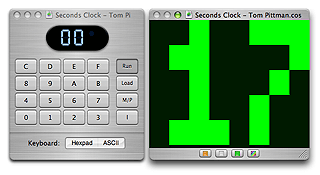
|
To run the video Seconds Clock, simply load it and click the Run button. |
The Seconds Clock is a sample program from Chapter 7 of A Short Course in Programming, which has been integrated into TinyELF's help book.
This simple program just counts the seconds on the hex display.
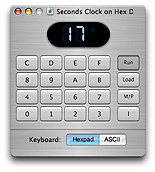
|
To run the hex display Seconds Clock, simply load it and click the Run button. |
When run, this program displays a picture of a spaceship. Bytes can be entered on the hex keypad to change the animation speed. The "garbage" at the top of the graphics display is really the program itself.

|
To run the Starship Animation program, first load it and click the Run button. The animation will begin when you use the hexpad to enter a non-zero byte and click the Input ("I") button. Entering a byte of 00 will stop the animation again. |
This program paints the image most associated with ELF computers from the 1970s. The program that drives the video is seen in the "garbage" at the top of the graphics display.
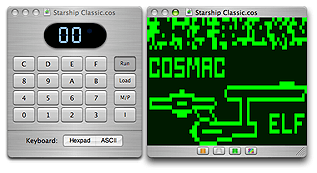
|
To run the Starship program, load it and click the Run button. This program allows you to do some primitive editing while it is running. First, key in the memory address at which you want to start changing memory; this should be a byte between 40 and FF (you can change bytes below 40, too, but you'll overwrite the display program itself!) Click the input button to enter the address. Now enter bytes, clicking the Input ("I") button after each one, and the bytes you enter will appear on the display in their binary form as a series of light and dark squares. |
Tango plays a few bars of a tango melody by simulating a speaker connected to the 1802's Q output.
|
To play the Tango, simply load it and click the Run button. Be sure you don't have the audio muted on your computer, and that you have adjusted TinyELF's volume on TinyELF's Preference panel. |
The Tango sample and the music program was written by Cec Williams; the article describing the program and its use is available online.
Note that Cec's program was written for an ELF with 256 bytes of memory and does not initialize the high bytes of registers. A new TinyELF computer has these registers zeroed anyway, but if you load the program into an TinyELF computer which has been running something else, or if you use the software on a real ELF with more that 256 bytes of memory, it may not work correctly without these registers initialized.
Tiny BASIC is a surprisingly flexible BASIC interpreter written by Tom Pittman, complete with its own proportionally-spaced character generator. Tiny BASIC fits in about 4,000 bytes of memory. In comparison, TinyELF's icon alone requires about 60,000 bytes of memory!
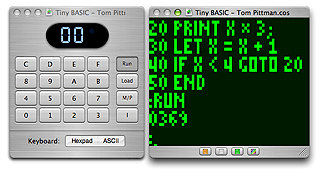
|
To run Tiny BASIC, start by loading it and clicking the Run button. You'll then need to make sure that the ASCII keyboard is selected using the control just beneath the hex keypad. Once it is, press the Enter or Return key on your Mac's keyboard, and within a second or two you should see the graphics window pop up with Tiny BASIC's colon prompt waiting for your input. |